NCERT Solutions for Class 11 Physics Chapter 3 Motion in a Straight LineNCERT Solutions for Physics Chapter 3 Class XI is an important resource for exam preparation. They include essential questions from CBSE sample papers and previous year's question papers, as well as answers to the questions from the textbook. Solutions to model problems are provided to assist you in exam preparation and verify your degree of readiness. All objects in the universe experience motion. While we sleep, blood continues to flow through our veins and arteries, and air enters and exits our bodies. Motion is the term for a change in an object's position over time. A student's 11th-grade year is crucial to develop a solid understanding of fundamental ideas. You will benefit from the material you learn with the NCERT Solutions for Class 11 Physics Chapter 3 because they are updated to align with the latest Syllabus (2022-23). NCERT Solutions Class XI Physics Chapter 3Question 1: In which of the following examples of motion can the body be considered approximately a point object?
Answer:
The bodies will therefore be regarded as a point object in options (a) and (b). Question 2: The position-time (x-t) graphs for two children, A and B, returning from their school O to their homes, P and Q, respectively, are shown in Fig. Choose the correct entries in the brackets
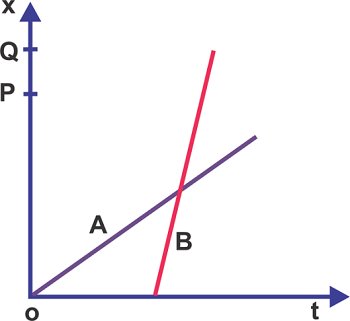
Answer:
Question 3: A woman starts from her home at 9.00 am, walks at a speed of 5 km/h on a straight road up to her office 2.5 km away, stays at the office up to 5.00 pm, and returns home by auto at a speed of 25 km/h. Choose suitable scales and plot the x-t graph of her motion. 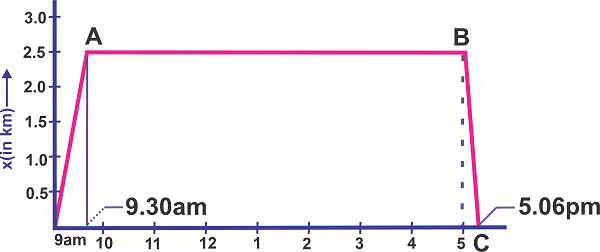
Answer: Distance between her office and home = 2.5 km. Speed of the woman while walking = 5 km/h Time taken to reach the office = (2.5/5 ) h=(1/2) h = 30 minutes Speed of auto = 25 km/h Time taken to reach home in auto = 2.5/25 = (1/10) h = 0.1 h = 6 minutes In the graph, O is taken as the origin of the distance and the time, then at t = 9.00 am, x = 0 and at t = 9.30 am, x = 2.5 km OA is the portion on the x-t graph that represents her walk from home to the office. AB represents her time of stay in the office from 9.30 to 5. Her return journey is represented by BC. Question 4: A drunkard walking in a narrow lane takes 5 steps forward and 3 steps backwards, followed again by 5 steps forward and 3 steps backwards, and so on. Each step is 1 m long and requires 1 s. Plot the x-t graph of his motion. Determine graphically and otherwise how long the drunkard takes to fall in a pit 13 m away from the start. Answer: In 1 second the drunkard walks 1 step. He moves 5m in forward direction in 5 seconds and also comes back 3m in the next 3 seconds. So in total the time period is 8 seconds and the man has covered a distance of 2m. Therefore we can say that in order to cover the distance of 8m the man will take 32 seconds. The remaining distance between man and pit is 5m and we know that in 5 seconds he covers 5m in forward direction. Therefore the man will take 32 + 5 = 37 seconds to fall into the pit which is at a distance of 13m. 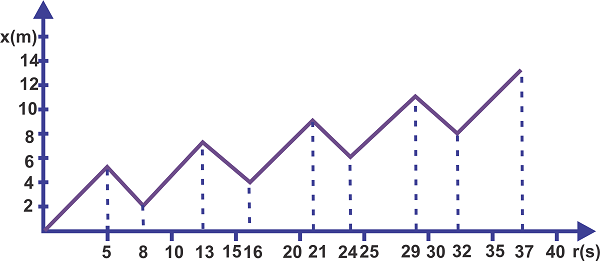
Question 5: A jet aeroplane travelling at the speed of 500 km/h ejects its products of combustion at the speed of 1500 km/h relative to the jet plane. What is the speed of the latter with respect to an observer on the ground? Answer: Let vA be the speed of the plane = 500 km/h Let vB be the speed of the ejected combustion products = vB-vA= - 1500 km/h (The combustion products go in the opposite direction of the jet, as indicated by the negative sign) Therefore combustion products speed with respect to observer on the ground is vB - 500 = - 1500 vB = -1500 + 500 = -1000km/h Question 6: A car moving along a straight highway with a speed of 126 km h-1 is brought to a stop within a distance of 200 m. What is the retardation of the car (assumed uniform), and how long does it take for the car to stop? Answer: Car has an initial velocity of = u Final velocity = v Total distance covered by car before it comes to rest = 200 m Using equation of motion we get, 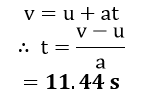
Therefore time taken by the car to come to rest is 11.44 seconds. Question 7: Two trains, A and B, of length 400 m each, are moving on two parallel tracks with a uniform speed of 72 km h-1 in the same direction, with A ahead of B. The driver of B decides to overtake A and accelerates by 1 m s-2. If, after 50 s, the guard of B just brushes past the driver of A, what was the original distance between them? Answer: Length of train A = 400 m Length of train B = 400 m Speed of both trains = 72 km/hr 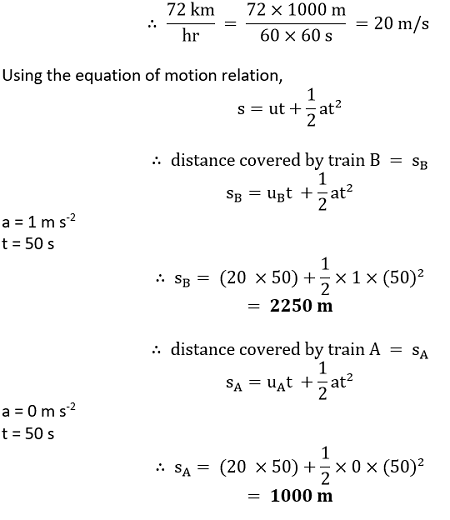
Thus the original distance between the two trains is sB - sA = 2250 - 1000 = 1250 m. Question 8: On a two-lane road, car A is travelling at a speed of 36 km/h. Two cars, B and C, approach car A in opposite directions with a speed of 54 km/h each. At a certain instant, when the distance AB is equal to AC, both being 1 km, B decides to overtake A before C does. What is the minimum acceleration of car B required to avoid an accident? Answer: Speed of car A = 36 km/h 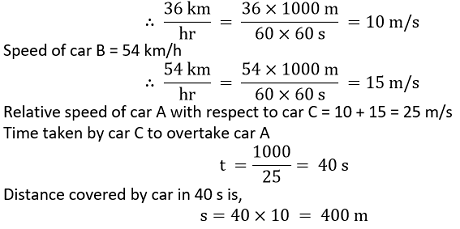
So car B needs to cover a total distance of 1000 + 400 = 1400 m. It means that if car B wants to overtake car A before car C then car B needs to cover 1400 m in 40 s. Using the equation of motion relation, 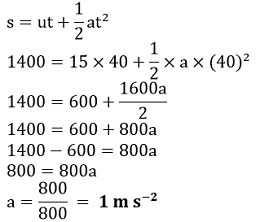
Thus car B can avoid accident by minimum acceleration of 1 m s-2. Question 9: Two towns, A and B, are connected by regular bus service, with a bus leaving in either direction every T minutes. A man cycling with a speed of 20 km h-1 in the direction A to B notices that a bus goes past him every 18 min in the direction of his motion and every 6 min in the opposite direction. What is the period T of the bus service, and with what speed (assumed constant) do the buses ply on the road? Answer: Let speed of each bus be = VB Let speed of the cyclist be = VC = 20 km/h Thus relative velocity of bus while travelling in the direction of motion of cyclist is VB - VC. The bus passes every 18 minutes when the bus is in the direction of motion of cyclist, thus the time is (18/60) s 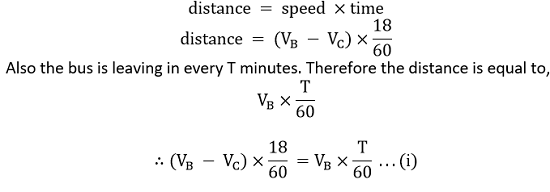
Thus relative velocity of bus while travelling in the opposite direction of motion of cyclist is VB + VC. The bus passes every 6 minutes when the bus is in the opposite direction of motion of cyclist, thus the time is (6/60) s 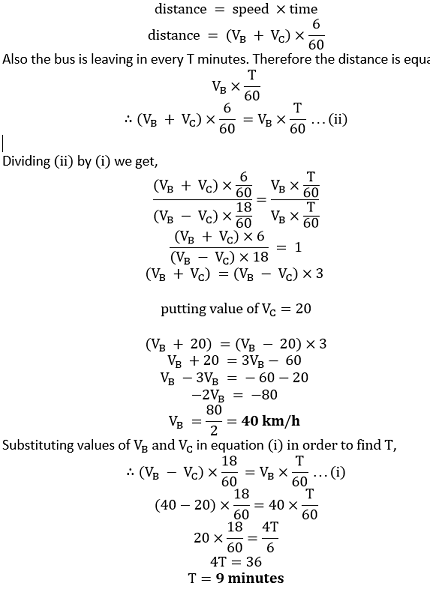
Question 10: A player throws a ball upwards with an initial speed of 29.4 m/s.
Answer: (a) No matter in what direction the body is moving the acceleration due to gravity always acts on the body in downwards direction towards the centre of earth. If the body is moving along the direction of gravity its speed increases on the other hand if it is moving in opposite direction of g its speed decreases. (b) Acceleration due to gravity is a fixed quantity and it always acts on body in downward direction towards center of earth. So no matter what it will always be 9.8 m s-2. However the velocity of the ball will become 0. This is because it is moving in the opposite direction of acceleration due to gravity which becomes opposing force and slowly it will make the velocity of the body zero and the body will then start falling in downward direction towards earth surface. (c) If we consider the highest point of ball motion as x = 0, t = 0, and vertically downward direction to be +ve direction of the x-axis, then
(d) Initial speed of the ball, u= -29.4 m/s final velocity of the ball, v = 0 m/s Acceleration due to gravity = 9.8 m/s-2 From equation of motion, 
Thus the maximum height reached by the ball -44.1 m and the negative sign indicates that the movement of the ball is in upward direction that is against g. From equation of motion, 
Thus the total time taken by the ball to reach back players hand is 3 + 3 = 6 seconds. Question 11: Read each statement below carefully and state with reasons and examples, if it is true or false; A particle in one-dimensional motion
Answer:
Question 12: A ball is dropped from a height of 90 m on a floor. At each collision with the floor, the ball loses one-tenth of its speed. Plot the speed-time graph of its motion between t = 0 to 12 s. Answer: Ball is dropped from the height of = 90 m While dropping the ball is stationary initially therefore initial velocity of the ball is = 0 m/s Let us consider v as the final velocity of the ball. Using the equation of motion we get, 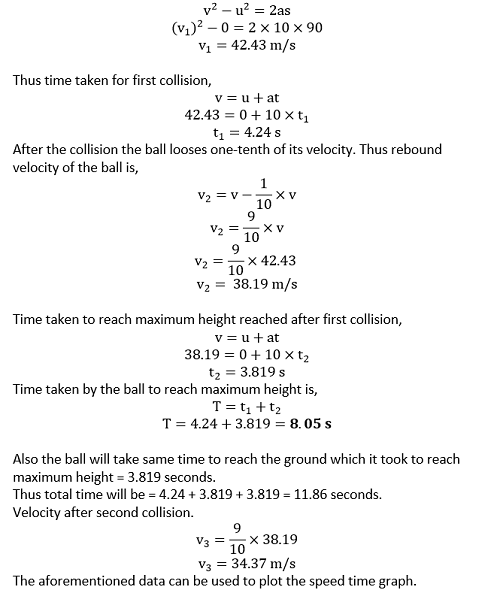
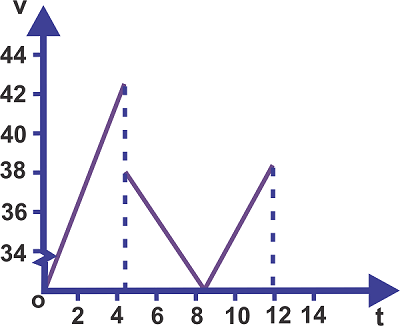
Question 13: Provide clear explanations and examples to distinguish between:
In (a) and (b), compare and find which of the two quantities is greater. When can the given quantities be equal? [For simplicity, consider one-dimensional motion only]. Answer: (a) Let us take an example of two players playing pass-pass with football. Suppose one of them is A and the other one is B. Now A hit the ball towards B and again B passed it back to A. Thus, the initial position and the final position of the ball is same as a result of which net magnitude of displacement is 0. But the distance covered by the ball is two times distance between the player A and B. (b) Let us consider the same example as above where the ball takes t seconds of time to cover the total distance. Therefore the magnitude of the average velocity of football will be given by 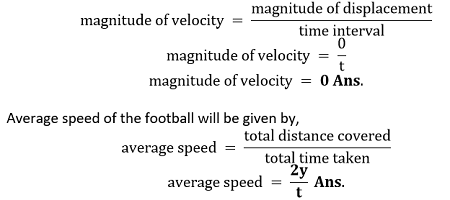
[y is the distance between the player A and B. It is 2 times because the football covered y distance from A to B and same distance again from B to A] Thus, the second quantity is greater than the first quantity. The above quantity are equal if the ball only moves from one player to another in a single direction (considering one-dimensional motion). Question 14: A man walks on a straight road from his home to a market 2.5 km away at a speed of 5 km/h. Finding the market closed, he instantly turns and walks back home with a speed of 7.5 km h-1. What is the
Answer: Distance between home and market is 2.5 km = 2500m Speed of the man while walking towards market is 5 km/hr 
(a) Magnitude of the average velocity is 0 because the main started from his home which is his initial position and came back home which is his final position also. So the initial and the final position is same therefore no displacement and no average velocity (b) 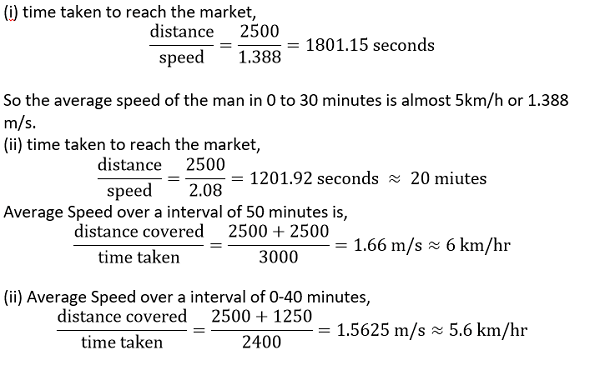
Question 15: In Exercises 3.13 and 3.14, we have carefully distinguished between average speed and the magnitude of average velocity. No such distinction is necessary when we consider the instantaneous speed and the magnitude of velocity. The instantaneous speed is always equal to the magnitude of instantaneous velocity. Why? Answer: The speed of an object at a specific moment or instant is its instantaneous velocity. Since the gap is so narrow, it is assumed that the object's direction of motion is remaining unchanged, causing the displacement and distance to become equal. Instantaneous speed and instantaneous velocity are therefore equivalent. Question 16 : Look at the graphs (a) to (d) carefully and state, with reasons, which of these cannot possibly represent the one-dimensional motion of a particle? 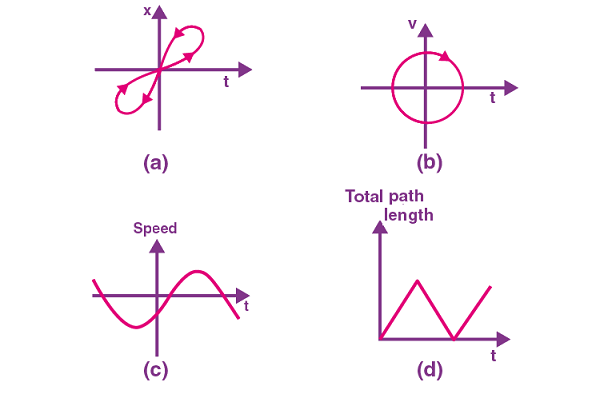
Answer: None of the four graphs shows a one-dimensional motion. One-dimensional motion is not represented by the graph (a). This is due to the fact that the item is in two places at a given time t, which is impractical for one-dimensional motion. One-dimensional motion is not represented by the graph (b). This is due to the particle having two opposing movements at a given time t. It is an illustration of two-dimensional motion or plane motion. Because it depicts a particle moving at a negative speed, graph (c) is incorrect. An object's speed cannot be negative. The particle's total route cannot shorten with time, hence the graph (d), which depicts the lengthening and shortening of the total path with time, cannot describe one-dimensional motion. Question 17: The figure shows the x-t plot of the one-dimensional motion of a particle. Is it correct to say from the graph that shows that the particle moves in a straight line for t > 0 and on a parabolic path for t >0? If not, suggest a suitable physical context for this graph. 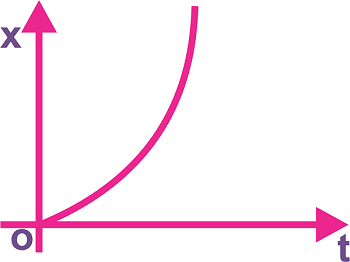
Answer: It is not correct to say that the particle moves in a straight line for t > 0 (i.e., -ve) and on a parabolic path for t > 0 (i.e., + ve) because the x-t graph does not represent the path of the particle. A suitable physical context for the graph can be the particle is dropped from the top of a tower at t =0. Question 18: A police van moving on a highway with a speed of 30 km h-1 fires a bullet at a thief's car speeding away in the same direction with a speed of 192 km h-1. If the muzzle speed of the bullet is 150 m s-1, with what speed does the bullet hit the thief's car? (Note: Obtain that speed which is relevant for damaging the thief's car). Answer: 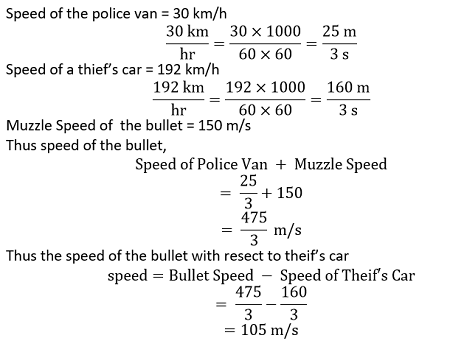
Question 19: Suggest a suitable physical situation for each of the following graphs. 
Answer: The velocity in the opposite direction suddenly increases in the graph (a) before dropping off. It resembles when a football player kicks a ball that is stationary in front of a vertical wall. The ball's velocity quickly rises when it is kicked. The ball bounces back in the opposite direction with a decreasing velocity after hitting the wall. The ball eventually comes to rest. The velocity in the graph (b) alternates between positive and negative signs, and each time, its magnitude falls. It is an illustration of a ball that freely falls from a height, bounces several times, and finally comes to rest. The acceleration suddenly increases over a brief period of time as seen in graph (c). A batter hitting a ball with a bat is an illustration of it. Question 20: The following figure gives the x-t plot of a particle executing one-dimensional simple harmonic motion. Give the signs of position, velocity and acceleration variables of the particle at t = 0.3 s, 1.2 s, - 1.2 s. 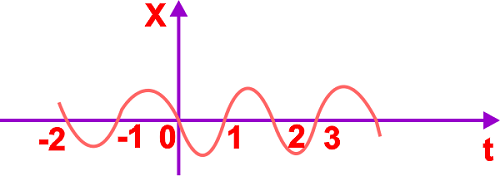
Answer: Negative, Negative, Positive (at t = 0.3 s) Positive, Positive, Negative (at t = 1.2 s) Negative, Positive, Positive (at t = -1.2 s) Acceleration of a particle exhibiting Simple Harmonic Motion (SHM) is given by the realtion, a = -?2 × ? ? angular frequency ...(i) For t = 0.3 s When time is 0.3 seconds then x is negative. So the slope of the x-t plot will also be negative as a result of which velocity and position both will be negative. However acceleration will be positive from equation (i). For t = 1.2 s When time is 1.2 seconds then x is negative. So the slope of the x-t plot will also be positive as a result of which velocity and position both will be positive. However acceleration will be negative from equation (i). For t = - 1.2 s When time is -1.2 seconds then x is negative. So the slope of the x-t plot will also be negative. Since x and t both are negative the velocity becomes positive. However acceleration will be positive from equation (i). Question 21: The figure gives the x-t plot of a particle in one-dimensional motion. Three different equal intervals of time are shown. In which interval is the average speed greatest, and in which is it the least? Give the sign of average velocity for each interval. 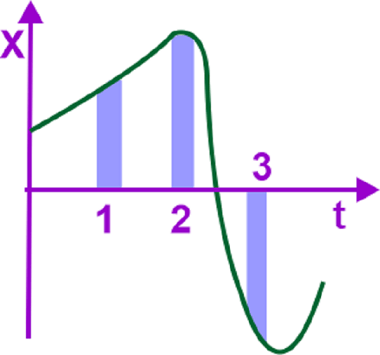
Answer: Interval 3 (Greatest), Interval 2 (Least) Positive (Intervals 1 & 2), Negative (Interval 3) The average speed of a particle shown in the x-t graph is obtained from the slope of the graph in a particular interval of time. The graph clearly shows that the slope is at its highest and lowest points at intervals 3 and 2, respectively. As a result, interval 3 has the highest average particle speed, whereas interval 2 has the lowest. Since the slope is positive in intervals 1 and 2, so is the average velocity in these intervals. In contrast, it is negative in interval 3 since this interval has a negative slope. Question 22: The following figure gives a speed-time graph of a particle in motion along a constant direction. Three equal intervals of time are shown. In which interval is the average acceleration greatest in magnitude? In which interval is the average speed greatest? Choosing the positive direction as the constant direction of motion gives the signs of v and a in the three intervals. What are the accelerations at points A, B, C and D? 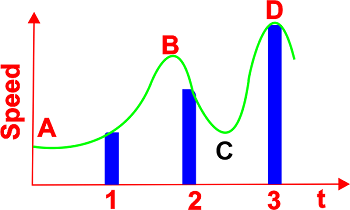
Answer: The maximum rate at which the speed changes over time is in interval 2. As a result, interval 2 experiences the largest average acceleration. In interval 3, the average speed is at its highest. The velocity in intervals 1, 2, and 3 is positive. The slope affects acceleration. Because the slope is positive, the acceleration is positive at intervals 1 and 3. Due to the negative slope in interval 2, the acceleration is also negative. Since the slope is parallel to the time axis at points A, B, C, and D, there is no acceleration at these locations. Question 23: A three-wheeler starts from rest, accelerates uniformly with 1 m s-2 on a straight road for 10 s, and then moves with uniform velocity. Plot the distance covered by the vehicle during the nth second (n = 1,2,3....) versus n. What do you expect this plot to be during accelerated motion: a straight line or a parabola? Answer: Distance covered by a body in nth-second in a straight line is, 
Where, a is the acceleration u is the initial velocity n stands for time interval where n = 1, 2, 3, . . ., n Thus in the above case Acceleration is 1m/s2, initial velocity u = 0 
From above equation we can relate that, SN ∝ n ...(iii) Substituting different values of n in equation (ii) we get,
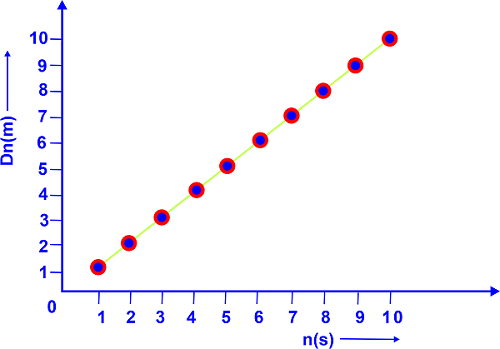
Thus the graph plotted will be a straight line. Question 24: A boy, standing on a stationary lift (open from above), throws a ball upwards with the maximum initial speed he can, equal to 49 m s-1. How much time does the ball take to return to his hands? If the lift starts moving up with a uniform speed of 5 m s-1 and the boy again throws the ball up with the maximum speed he can, how long does the ball take to return to his hands? Answer: The initial velocity of the ball, u = 49 m/s Case: I When the lift is still, the boy throws the ball upward. The upward direction is in vertical motion so it is taken as positive. The ball has no or zero displacement at all. From the equation of motion we know that, 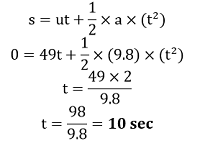
Case: II The ball will first move at a speed of (49 m/s + 5 m/s) = 54 m/s, when the lift begins to move at a speed of 5 m/s. Thus the ball will have a displacement of s = 5t' Therefore the time taken is 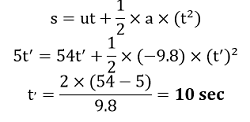
Both situations will involve the same amount of time. Question 25: On a long, horizontally moving belt figure, a child runs to and fro with a speed 9 km h-1 (with respect to the belt) between his father and mother located 50 m apart on the moving belt. The belt moves at a speed of 4 km h-1. For an observer on a stationary platform outside, what is the
Which of the answers alter if motion is viewed by one of the parents? 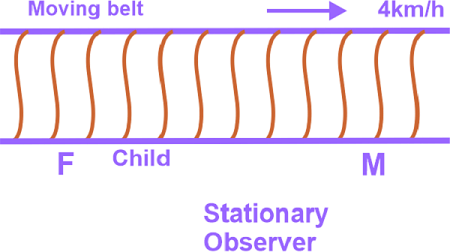
Answer: Speed of child = 9 km/h Speed of belt = 4 km/h
50 metres separate the child's parents. The child's speed in either direction as viewed by the parents will remain the same, i.e., 9 km/h = 2.5 m/s, while both parents are standing on the moving belt. As a result, the child needs 50/2. 5 = 20 seconds to travel toward one of his parents. Since the child and his parents are both standing on the same belt, the belt's motion affects them both equally. As a result, the child continues to move at the same speed of 9 km/h for both parents (regardless of the direction of mobility). This leads to the conclusion that the child still needs the same amount of time to get to any one of his parents. Question 26: Two stones are thrown up simultaneously from the edge of a cliff 200 m high with initial speeds of 15 m s-1 and 30 m s-1. Verify that the graph shown in Fig. 3.27 correctly represents the time variation of the relative position of the second stone with respect to the first. Neglect air resistance and assume that the stones do not rebound after hitting the ground. Take g = 10 m s-2. Give the equations for the linear and curved parts of the plot. 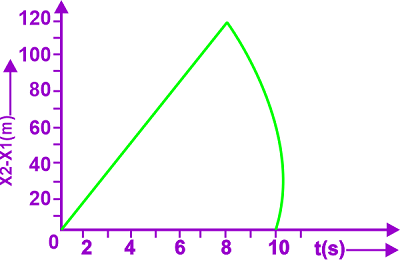
Answer: For the first stone: Given details are, Acceleration, a = -g = - 10 m/s2 Initial velocity, u1 = 15 m/s Now, we know 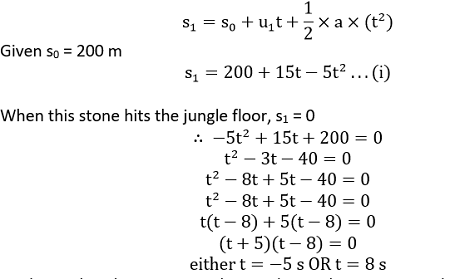
We know that the stone was thrown during the time interval t = 0 seconds therefore it cannot be negative as a result of which t = 8 seconds is correct. For the second stone: Given details are, Acceleration, a = - g = - 10 m/s2 Initial velocity, u2 = 30 m/s Now, we know 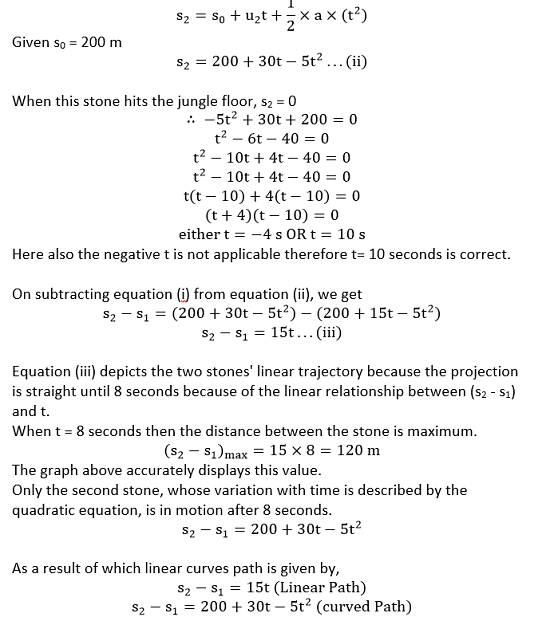 > >
Question 27: The speed-time graph of a particle moving along a fixed direction is shown in the figure. Obtain the distance traversed by the particle between
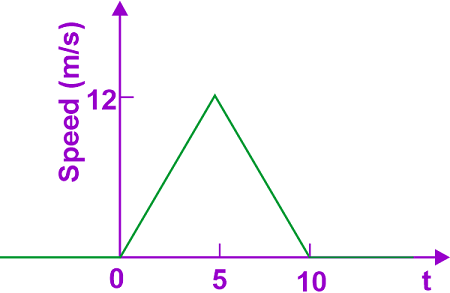
Answer: (a) During the first instance t = 0 s and t = 10 s, so distance traversed by the particle during this time period is, 
Average speed of the particle is given as 60m/10 s which is equal to 6 m/s (b) During the second instance t = 2 s and t = 6 s, so distance traversed by the Let S1 = disatnce travelled by the particle in time 2 to 5 seconds Let S2 = disatnce travelled by the particle in time 5 to 6 seconds For S1 we know that u = 0, t = 5 s, v = 12 m/s From equation of motion we know that, 
Distance covered from 2 to 5 s, S1 = distance covered in 5 sec - distance covered in 2 sec, From equation of motion we know that, 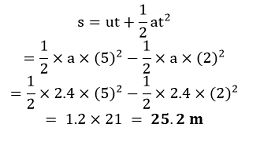
For the second instant that is when t = 5 sec to 10 sec, u = 12 m/s and a = -2.4 m/s2. Since t = 5 sec to t = 6 sec means n = 1 for this motion Distance covered in the 6 the sec is 
Question 28: The velocity-time graph of a particle in one-dimensional motion is shown in the figure.
Answer: The equations are given as,
Option (a), (b) and (e) are equations of a straight line. Also from the graph it is clear that graph between t1 and t2 consist of a non uniform slope as a result of which motion in this interval segment cannot be a straight line. Thus, options (a), (b) and (e) does not hole correct for motion of the particle within time interval t1 and t2. The ratio of the displacement at two different positions to the time interval difference is known as the average velocity. Thus average velocity between the time interval t2 and t1 will be given as, 
The ratio of the velocity difference between two points to the time interval difference is known as the average acceleration. 
The body's displacement between two time intervals is shown by the area under the velocity-time graph. This is so because displacement is the result of adding the corresponding time and velocity. Therefore the displacement between time interval t2 and t1 for the body will be given as x(t2) - x(t1)=area under the v - t curve bounded by the t-axis and the dotted lines Therefore, Options (c), (d) and (f) are the correct answers for this question.
Next Topic#
|
 For Videos Join Our Youtube Channel: Join Now
For Videos Join Our Youtube Channel: Join Now
Feedback
- Send your Feedback to [email protected]
Help Others, Please Share









